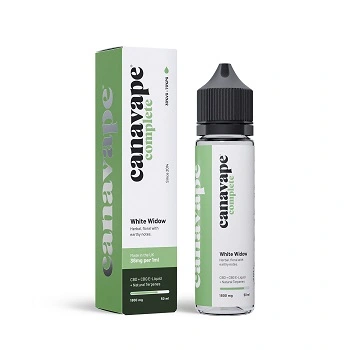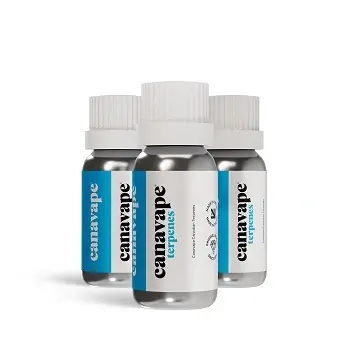
The growing popularity of cannabis products derived from the cannabis plant has sparked a lively debate on the benefits of flavours versus terpenes.
With a variety of options available, from CBD drinks to vapes, consumers are often faced with a choice between artificial flavourings and natural terpenes along with numerous cannabis strains.
Understanding the difference between these two can help you make an informed decision about what’s best for you and any potential benefits.
This guide will explore the distinct characteristics, benefits, and potential drawbacks of flavours and terpenes in cannabis products, providing you with the information needed to navigate this evolving market confidently.
Flavours in cannabis products typically come from artificial additives designed to enhance the sensory experience. These additives are common in products like CBD drinks and vape cartridges.
Artificial flavourings can mimic a wide range of tastes, from fruity to dessert-like, making them appealing to a diverse audience. However, these flavours often mask the natural taste of cannabis, which some consumers may prefer.
Additionally, there is ongoing debate about the safety and health implications of consuming artificial additives regularly.
While flavoured products can be enjoyable and offer a consistent taste experience, they may not provide the same therapeutic benefits that natural cannabis components, such as terpenes, offer.
Understanding the role and impact of artificial flavours in cannabis products is crucial for making an informed choice that aligns with your personal health and wellness goals.
Terpenes are natural compounds found in cannabis & cannabis plants that contribute to its aroma and flavour. Unlike artificial additives, terpenes are organic and occur naturally in many plants including the Cannabis plant, not just cannabis. You can find terpenes in many CBD vape and liquid cannabis products.
These compounds play a vital role in the plant’s defence mechanisms, protecting it from herbivores and attracting pollinators.
In cannabis plants, there are many different strains and terpenes are believed to offer therapeutic benefits, such as anti-inflammatory, anti-anxiety, and pain-relief properties.
Each terpene found within the cannabis plant has a distinct profile; for instance, myrcene has a musky, earthy scent, while limonene gives off a citrusy aroma.
The presence of terpenes & essential oils in different cannabis strains can enhance the ‘entourage effect,’ a phenomenon where various cannabis compounds work synergistically to produce a more pronounced therapeutic outcome.
From one cannabis plant to another, the terpene make-ups are unique. This distinct combination of essential oils is crucial, as it significantly contributes to the increasing variety of cannabis strains being cultivated by marijuana growers.
These growers aim for their plants to produce oils and extract compounds, such as live resin, with high terpene profiles. These profiles may contribute to additional psychoactive effects due to the presence of individual compounds, other terpenes, and variations in the final cannabis concentrates.
The importance of these unique terpene profiles cannot be overstated. They are a major factor in the breeding of different cannabis strains. Each strain’s specific terpene combination affects not only the flavour and aroma but also the potential therapeutic and psychoactive effects.
Marijuana growers meticulously select and cultivate plants to enhance these terpene profiles, aiming to create more potent and effective cannabis products.
Live resin, a popular cannabis extract, is especially valued for its rich terpene content. This high terpene profile in live resin can amplify the overall effects of the cannabis, providing a more nuanced and potentially more powerful experience for users.
The individual terpenes and their interactions with other compounds in the cannabis contribute to these enhanced effects, making the study and cultivation of terpene-rich strains a key focus for modern marijuana growers.
Understanding terpenes can help consumers choose products that not only taste and smell pleasant but also align with their wellness objectives.
When it comes to choosing between flavours and terpenes in cannabis products, several factors come into play. Artificial flavours can make products more palatable, especially for those new to cannabis. Cannabis concentrates, which include various extracts like CO2 oil and live resin, also play a significant role in the overall experience.
They offer a consistent taste and can mask the natural, often strong, taste of cannabis. However, the long-term effects of consuming artificial additives are still a subject of ongoing research. On the other hand, terpenes provide a natural alternative that not only enhances flavour but also offers potential therapeutic benefits.
Unlike artificial flavours, terpenes contribute to the ‘entourage effect,’ which can amplify the overall benefits of cannabis. While flavours may offer immediate sensory gratification, terpenes provide a multifaceted experience that aligns with holistic health goals.
Understanding the pros and cons of each can help you make an informed decision that best meets your needs and preferences.

CBD drinks have surged in popularity as a convenient and enjoyable way to consume cannabidiol. These beverages range from sparkling water to teas, often infused with various artificial flavours to make them more appealing.
The use of artificial flavours helps mask the earthy taste of CBD oil, making these drinks more accessible to a broader audience.
However, it’s important to note that many of these products contain minimal amounts of CBD, sometimes rendering the health benefits negligible. While the flavours make the drinks enjoyable, they do not contribute to the therapeutic properties of CBD.
The focus on taste over efficacy can be misleading for consumers seeking genuine health benefits.
As such, when choosing a CBD drink, it’s crucial to scrutinise the ingredients and CBD content to ensure you’re getting a product that meets your wellness needs.
Artificial flavours in CBD drinks come with their own set of advantages and disadvantages. On the plus side, they can make the beverage more palatable, especially for those who find the natural taste of CBD off-putting.
This makes CBD drinks more accessible and enjoyable, potentially attracting a broader consumer base. Moreover, artificial flavours offer consistency in taste, ensuring that each drink has the same flavour profile.
However, there are several drawbacks to consider. The most significant concern is the potential health risk associated with consuming artificial additives regularly.
While they are generally recognised as safe, the long-term effects are not fully understood. Additionally, these flavours do not contribute to the therapeutic benefits of CBD.
They can also mask the quality of the CBD used, making it harder for consumers to assess the product’s efficacy.
Balancing taste with health benefits is crucial when choosing a CBD drink.
One of the key factors consumers should consider when purchasing CBD drinks is the actual CBD content. Many commercially available CBD beverages contain only trace amounts of cannabidiol, often insufficient to provide any noticeable therapeutic effects.
The emphasis on flavour and drinkability can sometimes overshadow the importance of CBD potency. It’s crucial to read the label and verify the amount of CBD per serving to ensure you are getting a product that meets your health and wellness needs.
Ideally, a quality CBD drink should clearly state the CBD content, allowing consumers to make informed decisions. Additionally, some products may use low-quality CBD isolate, which lacks the beneficial entourage effect provided by full-spectrum CBD.
Therefore, understanding the type and amount of CBD in your drink can help you choose a product that offers both a pleasant taste and genuine benefits.
While many CBD drinks on the market claim to offer therapeutic benefits, it’s important to consider the bioavailability of CBD in these products. Bioavailability refers to the proportion of a substance that enters the bloodstream when introduced into the body and is thus able to have an active effect.
CBD drinks typically contain around 10mg of CBD per can or serving. However, the actual effectiveness of this CBD can be significantly compromised due to the poor bioavailability of CBD in liquid form.
When CBD is ingested, it must pass through the digestive system and liver before entering the bloodstream, a process known as first-pass metabolism.
During this process, a substantial amount of CBD can be broken down and eliminated, resulting in lower bioavailability and reduced efficacy.
CBD oils and tinctures taken sublingually (under the tongue) have higher bioavailability because the CBD is absorbed directly into the bloodstream through the mucous membranes. In contrast, CBD drinks must be processed by the digestive system, where much of the CBD is lost.
This means that even if a drink contains 10mg of CBD, the amount that actually reaches the bloodstream is much lower.
When choosing CBD products, especially drinks, it’s essential to understand these factors. Here are a few tips to ensure you’re getting a quality product:
Terpenes are organic compounds found in many plants, including cannabis, that are responsible for their distinct aromas and flavours. These compounds play a crucial role in the plant’s ecology, helping to attract pollinators and repel pests.
In cannabis, terpenes not only contribute to the plant’s unique scent but also offer various potential health benefits. Essential oils, which are rich in terpenes, are commonly found in citrus fruits like lemons and oranges and are used in foods, cosmetics, and cleaning products.
There are over 100 different terpenes identified in cannabis, each with its own flavour profile and therapeutic properties. For instance, limonene provides a citrusy aroma and has been studied for its potential anti-anxiety effects, while linalool offers a lavender scent and is believed to have calming properties.
The presence of terpenes can significantly enhance the overall experience of consuming cannabis, providing a more holistic approach to wellness.
Understanding what terpenes are and their benefits can help consumers make more informed choices when selecting cannabis products.
Natural terpenes in cannabis offer a variety of benefits that extend beyond just flavour and aroma. These organic compounds are believed to have therapeutic properties that can enhance the overall effects of cannabis.
Terpenes are aromatic molecules found in many plants, including cannabis, and they play a crucial role in the plant’s interaction with the environment, such as attracting pollinators and deterring pests.
For instance, myrcene, known for its musky scent, is thought to have sedative and anti-inflammatory effects, making it beneficial for pain relief and relaxation. Scientific studies have shown that myrcene can increase the permeability of cell membranes, which allows for faster and more efficient absorption of cannabinoids into the bloodstream.
This could explain why strains high in myrcene are often more potent and fast-acting. Additionally, myrcene has been observed to have muscle relaxant properties, which can be particularly beneficial for individuals suffering from chronic pain or muscle spasms.
Limonene, with its citrusy aroma, is associated with mood enhancement and stress relief. This terpene is commonly found in citrus fruits and has been widely studied for its potential antidepressant and anxiolytic effects.
Research suggests that limonene can elevate serotonin and dopamine levels in the brain, which are neurotransmitters associated with mood regulation.
Moreover, limonene has shown promise in reducing anxiety and improving cognitive function, making it a valuable terpene for those looking to enhance mental clarity and emotional well-being.
Linalool, which has a floral lavender scent, is recognised for its calming and anxiolytic properties. This terpene is abundant in lavender and is a key component of aromatherapy practices aimed at reducing stress and promoting relaxation.
Scientific evidence indicates that linalool can modulate the GABAergic system, the primary inhibitory neurotransmitter system in the brain, which helps in reducing anxiety and inducing a state of calm.
Additionally, linalool has been found to have anti-inflammatory and analgesic properties, further contributing to its therapeutic potential.
The presence of these terpenes can contribute to the ‘entourage effect,’ where the combined effect of cannabinoids and other terpenes is greater than the sum of their individual effects. This phenomenon is supported by research indicating that terpenes can enhance the therapeutic effects of cannabinoids by modulating their interaction with the endocannabinoid system.
For example, terpenes can influence the binding affinity of cannabinoids to cannabinoid receptors, thereby enhancing their efficacy.
This makes natural terpenes a valuable component for those seeking a holistic approach to wellness.
Understanding these benefits, along with the potential properties of other compounds in cannabis, can guide consumers in choosing cannabis products that align with their health objectives. For instance, beta-caryophyllene, a terpene with a spicy, peppery aroma, has been found to interact directly with CB2 receptors in the endocannabinoid system, providing anti-inflammatory and analgesic benefits without the psychoactive effects associated with THC.
Similarly, pinene, another common terpene with a pine-like scent, has been shown to possess bronchodilator properties, which can help improve airflow and respiratory function.
In addition to these benefits, terpenes also have antimicrobial properties, which can contribute to the overall health benefits of cannabis products. Studies have demonstrated that certain terpenes, such as terpinolene and eucalyptol, exhibit strong antibacterial and antifungal activities.
This not only helps in preserving the quality of cannabis products but also adds a layer of protection for consumers against harmful pathogens.
Furthermore, the combination of terpenes and cannabinoids can lead to a more balanced and nuanced therapeutic effect. For example, while THC is known for its psychoactive properties, the presence of terpenes like myrcene and linalool can mitigate the potential anxiety-inducing effects of THC, resulting in a more relaxed and comfortable experience.
This highlights the importance of considering the terpene profile when selecting cannabis products, as it can significantly influence the overall effects and benefits.
Terpenes play a significant role in the overall experience of cannabis products. These natural compounds are found in varying concentrations across different strains of cannabis, contributing to the unique profiles of each product. The similarities in the chemical composition and physical properties of cannabinoids like CBD and THC necessitate their separation, especially since THC is a psychoactive and controlled drug substance.
For example, a strain high in pinene will have a pine-like aroma and may offer anti-inflammatory and bronchodilator benefits, making it useful for respiratory conditions. Products like full-spectrum CBD oils, vape cartridges, and edibles often highlight their terpene content to attract consumers who are looking for specific effects.
The presence of terpenes can enhance the therapeutic benefits of cannabinoids through the entourage effect, making the product more effective. When shopping for cannabis products, it’s beneficial to consider the terpene profile to better match your needs and preferences.
Understanding the role of terpenes can help you select products that not only appeal to your senses but also support your wellness goals.
The entourage effect is a phenomenon where various cannabis compounds, including terpenes and cannabinoids, work together to enhance the overall therapeutic effects of the plant. This synergy means that the combination of these compounds can produce a more significant impact than any single compound alone.
For instance, myrcene, a common terpene with sedative properties, can amplify the relaxing effects of CBD, making the combination particularly effective for sleep and stress relief.
When selecting cannabis products, paying attention to the terpene profile can provide insights into the potential effects.
For example, limonene is known for its uplifting and mood-enhancing properties, making it a good choice for daytime use or for alleviating symptoms of depression.
On the other hand, linalool, which has a floral aroma, is noted for its calming and anti-anxiety effects, making it suitable for evening use.
Several terpenes are frequently found in cannabis products, each offering unique benefits:
Understanding these terpenes can help you choose products tailored to your specific needs and preferences, whether you are looking for relaxation, pain relief, or mood enhancement.
Full-spectrum CBD products are particularly notable for their rich terpene profiles. Unlike CBD isolates, full-spectrum products contain a wide range of cannabinoids and terpenes, providing a more comprehensive array of benefits.
The presence of multiple compounds working together can enhance the therapeutic potential through the entourage effect.
When choosing full-spectrum CBD oils, vape cartridges, or edibles, it’s essential to consider the listed terpene profiles. These profiles can provide guidance on what effects to expect and how the product can best meet your wellness goals.
For example, a full-spectrum oil rich in limonene and pinene may be more suitable for daytime use, offering an uplifting and energizing effect.
When shopping for cannabis products, looking at the terpene content can significantly influence your decision. Here are a few tips to help you choose terpene-rich products:
The health impacts of artificial flavours and natural terpenes in cannabis products can vary significantly. Artificial flavours are often used to enhance taste, but their long-term health effects are still not fully understood.
While these additives are generally recognised as safe by regulatory authorities, there are concerns about potential risks associated with prolonged consumption.
On the other hand, natural terpenes, found in the hemp plant, offer not only flavour and aroma but also potential health benefits. Terpenes like myrcene, limonene, and linalool have been studied for their anti-inflammatory, anti-anxiety, and pain-relief properties.
Furthermore, the entourage effect suggests that terpenes can enhance the therapeutic benefits of cannabinoids, making them a more holistic option.
In comparing the two, natural terpenes provide an added layer of wellness benefits that artificial flavours lack, making them a preferable choice for those focused on health and well-being.
Taste and aroma are critical factors when comparing flavours and terpenes in cannabis products. Artificial flavours are designed to provide a consistent and often intense taste experience, making them appealing to a wide range of consumers.
These flavours can mimic anything from fruity to dessert-like profiles, offering a pleasant and predictable sensory experience. However, the artificial nature can sometimes result in a taste that feels less authentic.
In contrast, natural terpenes offer a more nuanced and complex flavour and aroma profile. Derived from the cannabis plant itself, terpenes like myrcene, limonene, and pinene contribute to the plant’s unique sensory characteristics.
These natural compounds provide an earthy, citrusy, or pine-like aroma that many cannabis enthusiasts prefer. The authenticity and depth of flavour that terpenes bring can enhance the overall experience, making it more enjoyable and aligned with holistic wellness.
Understanding these differences can help you choose a product that best fits your preferences.
Cost and availability are important considerations when comparing flavours and terpenes in cannabis products. Artificial flavours are generally cheaper to produce and more readily available, which can make products containing them more affordable.
This cost-effectiveness allows manufacturers to offer flavoured cannabis products at a lower price point, making them accessible to a wider audience. Additionally, the consistency of artificial flavours ensures a uniform product experience with every purchase.
On the other hand, natural terpenes can be more expensive to source and extract. The complexity involved in preserving the terpene profile during the production process can also contribute to higher costs.
As a result, cannabis products rich in natural terpenes may come at a premium price. However, the added cost often reflects the quality and potential therapeutic benefits of these products.
When weighing cost and availability, consumers must decide whether the enhanced flavour and health benefits of natural terpenes justify the higher price compared to artificial flavours.

Personal preferences play a significant role in deciding between flavours and terpenes in cannabis products. Some consumers may prioritise taste above all else, opting for products with artificial flavours that offer a consistent and enjoyable experience.
These individuals might prefer the predictability and variety that flavoured products provide, especially if they find the natural taste of cannabis unappealing.
Conversely, other consumers might lean towards natural terpenes due to their potential therapeutic benefits and authentic flavour profiles. For these users, the earthy, citrusy, or pine-like aromas and tastes of terpenes enhance the overall experience, aligning more closely with their health and wellness goals.
Ultimately, the decision comes down to what you value most in your cannabis consumption experience. Whether it’s the enjoyable taste of artificial flavours or the holistic benefits of natural terpenes, your personal preferences will guide you in making the right choice for your needs.
Product labelling and information are crucial when choosing between flavours and terpenes in cannabis products. Transparent and detailed labelling helps consumers make informed decisions, ensuring they know exactly what they are consuming.
Look for products that clearly state the type and concentration of CBD, as well as the presence of any artificial flavours or natural terpenes.
Labels should also provide information on the extraction methods used, the source of the cannabis, and any third-party lab testing results. This transparency can help you assess the quality and safety of the product.
For those who prioritise natural terpenes, look for labels that specify the terpene profile, including the types and amounts present.
Conversely, if you prefer flavoured products, ensure the label lists the flavouring agents used. Understanding product labelling can guide you in selecting cannabis products that align with your taste preferences and health objectives, making your choice both enjoyable and beneficial.
Third-party lab testing is an essential aspect of product labelling that ensures the quality and safety of cannabis products. Independent laboratories test these products for cannabinoid content, terpene profiles, and the presence of contaminants such as pesticides, heavy metals, and residual solvents. This unbiased verification helps build trust between consumers and manufacturers.
When evaluating a product, check for lab results that confirm the advertised CBD and THC levels, as well as the terpene content. Lab reports should be easily accessible, either through a QR code on the packaging or upon request from the manufacturer. This transparency not only assures the product’s safety but also verifies its potency, giving consumers confidence in their purchase.

The extraction method used to produce cannabis products can significantly impact their quality and effectiveness. Common methods include CO2 extraction, ethanol extraction, and solvent-based extraction. Each method has its pros and cons, and understanding these can help you make an informed choice.
Understanding the extraction method used can help you choose a product that meets your quality standards and health preferences.
Terpenes are aromatic compounds found in cannabis that contribute to the plant’s unique scent and flavour. They also play a significant role in the effects of different cannabis strains. Understanding terpene profiles can help you select products that cater to your desired experience.
By checking the terpene profile on the product label, you can choose cannabis products that align with your preferences for aroma, flavour, and desired effects.
Flavouring agents in cannabis products can significantly enhance the vaping or consumption experience. These agents can be natural or artificial, and understanding their role can help you make a more informed choice.
When selecting flavoured cannabis products, ensure the label clearly lists the flavouring agents used. This transparency helps you avoid unwanted additives and enjoy a product that matches your taste preferences.
Expert recommendations can provide valuable insights when choosing between flavours and terpenes in cannabis products.
Many health professionals and cannabis experts advocate for products rich in natural terpenes due to their potential therapeutic benefits and contribution to the entourage effect.
They often recommend full-spectrum or broad-spectrum CBD products, which retain these beneficial compounds, over those with artificial flavours.
Experts also emphasise the importance of transparency and quality in product selection. They advise consumers to look for third-party lab testing results to verify the cannabinoid and terpene content, as well as the absence of harmful additives.
For those new to cannabis, consulting with a knowledgeable professional can help tailor recommendations to individual health needs and preferences.
While artificial flavours can make cannabis products more enjoyable for some, experts generally favour natural terpenes for their holistic benefits. Following expert advice can guide you in making choices that enhance both your enjoyment and wellness.